Keywords
|
| Hand geometry, Biometrics system, retrieval, identification |
INTRODUCTION
|
| Automatic personal identification is a significant component of security systems with many challenges and practical applications. The advances in biometric technology have led to the very rapid growth in identity authentication. Our project presents an approach to personal identification using hand geometry. Hand geometry based biometric systems are gaining acceptance in low to medium security applications Here we attempts to scientifically develop a comprehensive set of hand geometry features and develop an original algorithm from a fundamental level to robustly compute a selected set of features so as to minimize palm placement effect. These features are combined with chrominance features, to achieve recognition and verification accuracy, significant with respect to the current state in palm biometrics research. The algorithm has been kept robust, simple and computationally efficient while the implementation is relatively inexpensive. |
| The problem of personal recognition and verification using palm biometrics features has drawn considerable attention and researchers have proposed various methods. One popular approach considers palmprints as textured images which are unique to every individual. Therefore, analysis of palmprint images using Gabor filters, wavelets, Fourier transform [4], and local texture energy [5] has been proposed in the literature. The US patent office has issued several patents for devices that measure hand geometry features for personal verification. A perfect (100 percent correct recognition accuracy and zero percent FAR and FRR in verification) recognition/verification accuracy has not been achieved using hand geometry features alone, and maximum number of hand geometry features used are not more than 24 [2], [6].Hand geometry features have been earlier stated as not being very distinctive and they have been combined with palm print features to achieve better results as in [7]. Eigen face approach which is more popular for face recognition has also been applied for palm biometrics. It confirms the utility of using PCA, which has also been further experimented in this paper. The two best schemes for palm biometrics in the literature are the complex wavelet transforms scheme and competitive coding scheme. The performance of our algorithm, which uses a comprehensive set of hand geometry features alone, has been compared with these works. The section I explains why hand geometry is used? Section II is helpful to understand the proposed system. The section III shows the experiments and the results. At last section IV concludes the paper and followed by the references. |
| Why Hand Geometry? |
| What is the most effective biometric measurement? There is no ideal biometric measurement [2]; each biometrics has its strengths and limitations, and accordingly each biometric appeal to a particular identification (authentication) application. for (infrequent) identification and use the hand geometry for (frequent) verification. Suitability of a particular biometric to a specific application depends upon several factors; among these factors, the user acceptability seems to be the most significant. For many access control applications, like immigration, border control and dormitory meal plan access, very distinctive biometrics, e.g., fingerprint and iris, may not be acceptable for the sake of protecting an individual's privacy. In such situations, it is desirable that the given biometric indicator be only distinctive enough for verification but not for identification. As hand geometry information is not very distinctive, it is one of the biometrics of choice in applications like those mentioned above. |
| Hand geometry-based authentication is also very effective for various other reasons. Almost all of the working populations have hands and exception processing for people with disabilities could be easily engineered. Hand geometry measurements [2] are easily collectible due to both the dexterity of the hand and due to a relatively simple method of sensing which does not impose undue requirements on the imaging optics. Note that good frictional skin is required by fingerprint imaging systems, and a special illumination setup is needed by iris or retina-based identification systems. Further, hand geometry is ideally suited for the integration with other biometrics, in particular, finger prints. For instance, an identification or verification system may use the fingerprints |
PROPOSED SYSTEM
|
| Biometric devices consist of 3 elements: |
| a) Scanner- captures the user’s biometrics characteristics |
| b) Software-converts the data into digital form and compare it with the previously recorded data. |
| c) System database- stores the biometric data |
| Fig.1. shows the proposed system at block level. Feature Vectors for all images in the database have been calculated in the feature extraction module, and stored in the form of a text file, called the system database. In the matching module feature vector has been calculated from the query image and compared with the system database. A decision for verification or recognition is taken as per the problem targeted. Both the aspects (recognition and verification) have been tested and the results have been discussed in this paper. |
| The block diagram of the palm recognition system is as shown below: |
| A. BIOMETRIC SNAPSHOT |
| In the Image Acquisition setup featured a platen on which a person placed his/her hand and a webcam that captured the image of hand’s top views. This setup is relatively inexpensive as compared to the fingerprint sensors. A database of 10 users has been prepared, taking image of the right hand for each user. The fingers must be clearly separated from each other in the image in order to obtain a complete hand shape. Background should be a dark one. The image acquisition setup does not employ any special illumination. Ideally, the placements of the hand on the platen at enrolment and verification need to be identical. Special markings are provided on the platen to position fingers. No pegs are used on the platen. |
| B. FEATURE EXTRACTION |
| 1) Feature selection: A careful study of anatomy of human hand reveals a large number of features useful in palm biometrics. The area of the distal phalanx, middle phalanx and proximal phalanx for each finger as shown in figure 4 is a distinctive feature of the hand anatomy. Also the thickness at joints distal interphalangeal (DIP), proximal interphalangeal (PIP) and metcarpophalangeal (MCP) [1] are distinctive features which varies from person to person, an established fact in the art of palmistry. |
| Apart from these features, the overall palm area, the elongation indices of the fingers the perimeter, area and circularity of the palm are known to be very distinctive in nature. The ratio of the length and area of the features, also preserve a good amount of information. All these features when combined together form a comprehensive set of 19 features. The extracted features are |
| a) Finger Length(4) |
| b) Finger Width(4) |
| c) Area of the Distal Phalanx(4) |
| d) Length to Width Ratio(4) |
| e) Area of the Palm |
| f) Perimeter of the Palm |
| g) Differences with Centre Ratio |
| 2) Pre-processing: The goal of digital image pre-processing is to increase both the accuracy and the interpretability of the digital data during the image processing phase. The input image is a grayscale image of the left palm without any deformity. The input image, shown in Figure 4 is stored in jpeg format. |
| In cases of standard deformity such as a missing finger the system expresses its inability to process the image. It is also critical that the fingers are separated from each other. However it is not required to stretch the fingers to far apart as possible. The hand should be placed in a relaxed state with fingers separated from each other. Since features such as length and width which are dependent on the image size and resolution are being used, it is critical that to have uniform size of images. |
| In pre-processing the image in jpeg format is converted to a gray scale image which is shown in Figure 5. |
| Red, green and blue (RGB) values of each pixel are extracted. Since a monochromatic image is required for the proposed system a threshold is determined. All pixels with RGB values above the threshold are considered white pixels and all pixels below the threshold are considered black pixels. Initially the threshold is set very low, very close to the RGB value of a black pixel in the image. This produces an image with a completely white palm on a black background as shown in Fig.5. Features such as finger lengths perimeter and area of the palm can be more easily extracted from this image. However, very low threshold value results in a lot of noise in the image. A good threshold is determined and then noise removal algorithms are applied to the image |
| 3) Boundary extraction: The image obtained after elimination of noise contains regions of black and white pixels. In order to extract geometric features of the palm it is required that the image contains only edges. Consequently it is required to convert regions of white space to an image containing only the boundary of the white pixels. This is achieved by using an edge detection algorithm. The algorithm converts all pixels excluding those at the boundary of black and white regions to black pixels. The algorithm also has to ensure that the thickness of this boundary is as low as possible. This is because a thick boundary will adversely affect the accuracy of the feature detection algorithm. |
| pixels. The algorithm also has to ensure that the thickness of this boundary is as low as possible. This is because a thick boundary will adversely affect the accuracy of the feature detection algorithm. |
| The method used is robust, works irrespective of palm placement effects, and gives a continuous and a very good quality boundary, which improves the accuracy of all subsequent processing. |
| The primary task is anatomical feature extraction for which the boundary image needs be accessed and scanned repeatedly. To save computation the boundary co-ordinates are stored in a lower dimensional matrix which would provide easy and fast access. Thus all the boundary information is stored in a matrix which stores only the row and column coordinates of all boundary encounters while moving in the image from left to right. |
| 4) Locating a set of Reference Points: Feature extraction primarily requires that the image be segmented into some relevant regions for reference, which would require knowledge of some special reference points like valleys between the fingers, tips of the fingers etc. Fig.7. shows the set of reference points marked in colour. |
| a) Tip of fingers |
| The tip of the middle, index, ring and small finger is computed from the edge detected image. It is the first white pixel of each finger respectively. Tip is required for finding the length of the finger |
| b) Upper Centre |
| The upper centre is the representative of upper part of the finger. It is computed as the second white pixel which lies in the same column of tip of the finger. It is useful in finding the width of the fingers.c |
| c) Lower Centre |
| The lower centre is the representative of lower part of the finger. It is third white pixel which lies in the same column of tip of the finger. |
| d) Start Point |
| The start point is the fourth white pixel in the edge detected image of each finger respectively. |
| x5) Computing the features: Once the special reference points are located in the image, a comprehensive set of palm geometry features is computed. |
| a) Finger Length |
| The length of the four fingers except thumb is calculated. The length of the finger is the Cartesian distance between the tip and start point. If tip is assigned by (x1,y1) and start point is (x2, y2), then the length is given by |
| L=√ ((x2-x1)²+ (y2-y1)²) |
| b) Finger Width |
| Width of the finger is calculated from the binarized image. We measured Width at distal phalangeal only. For finding the width first determine the Upper Centre (x, y), then locate the left and the right ends of the finger at this region. for that, traverse to the right starting from the upper centre until a black pixel is located(x,y1), traverse to the left starting from the upper centre until a black pixel is located.(x,y2) finger width is obtained as the difference between the points located. . |
| W= y2-y1 |
| c) Area of Distal Phalanx |
| Area of distal phalanx is the number of white pixels in the distal phalangeal of each finger respectively. |
| d) Area of palm |
| Palm area is the number of white pixel in the binarized image. |
| e) Length to Width ratio |
| It is the ratio of the length of distal phalanx to the width of each finger. |
| R= d/w Where d is the length of distal phalanx and w is the width of finger. |
| f) Perimeter of the Palm |
| The edge of the palm is extracted using prewitt operator. The edge detection is done by using function edge. The palm perimeter is the number of white pixel in the edge detected image in the image. |
| g) Difference with Centre Ratio |
| If C is the length of central finger, I is the length of index finger and R is length of the ring finger, then this feature is calculated as (C - I) divided by (C – R) |
| C. SYSTEM DATABASE |
| Feature Vectors for all images in the database have been calculated in the feature extraction module, and stored in the form of a text file, called the system database. A feature with good discriminating ability should exhibit a large variance between individuals and small variance between samples from the same person |
| D. MATCHING |
| The change in the positioning of the sensors and various noise elements can make impossible to duplicate the identical environment as during the time of registration. Also the characteristic may undergo changes however little they may be with time. The result of all this may lead to no perfect match being found for the individual in the database. This requires the matching algorithm to return results which are near matches to the characteristic given. |
| As only one result is desired a match which is as close to the original characteristic as possible is required. So the matching algorithm can be designed to simply return the closest match. This however presents the problem that in even the case when individual is not registered with the system, it may return the closest match to that individual. It may of course not be as near a match as that of a registered individual but it effectively renders the system useless as both registered and unregistered individuals are recognized. To prevent this threshold is used. Only the matches which are above a certain threshold are said to be valid and the others are rejected. |
| This process involves matching a given hand to person previously enrolled in the system. The given feature vector is then compared with the feature vector stored in the database associated with the claimed identity. Let F=(f1, f2, ..... fd) represent the d-dimensional feature vector in the database associated with the claimed identity and Y = (y1, y2,..... yd) be the feature vector of the hand whose identity has to be verified. The verification is positive if the distance between F and Y is less than a threshold value. |
 |
| E. DECISION MODULE |
| The person, whose image is found closest to the database, would be the recognized person. Decision is made based on the distance value obtained from the matching module. The person with minimum value of Absolute distance is considered as the recognized person. The system decides whether it will accept or reject the claimer by comparing the distance to a predefined threshold. Name of the recognized person is displayed. |
EXPERIMENTS AND RESULTS
|
| There are 50 test users in our experiments. One image of the right hand is acquired from each user. It is used for the enrolment process to define the users’ templates, or feature vectors. The features are extracted as mentioned earlier in section B. |
| Out of the 50 users 48 are correctly matched. So accuracy of the system is about 96%. From the experiment, it is found that absolute distance function gives the best performance. So this method is adopted for matching. |
CONCLUSION
|
| The use of biometrics as a reliable means meeting the security concerns of today’s information and network based society cannot be belittled. Biometrics is being used all over the globe and is undergoing constant development. The Hand geometry has proved to be a reliable biometric. The proposed work shows how to utilize the shape of the palm to extract features using very simple algorithms.. We are attempting to improve the performance of hand geometry based verification system by reducing the amount of features and integrating new features. We hope that our work will improve the performance of existing hand-geometry. |
Figures at a glance
|
 |
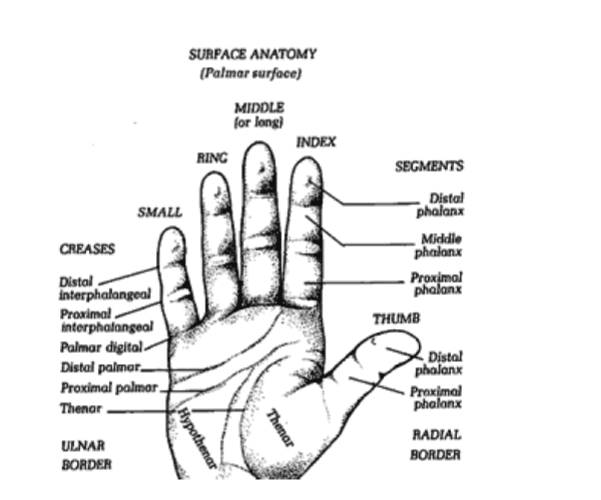 |
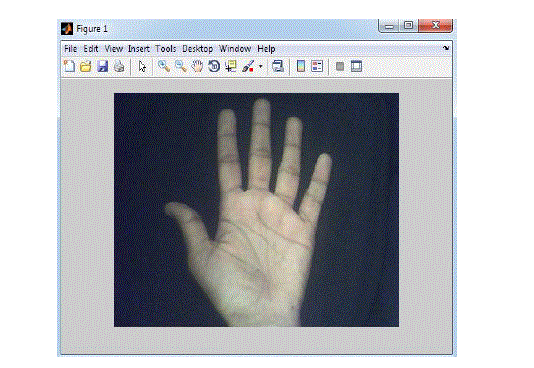 |
| Figure 1 |
Figure 2 |
Figure 4 |
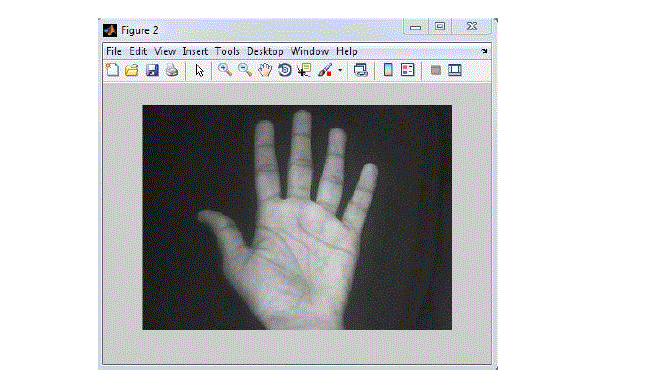 |
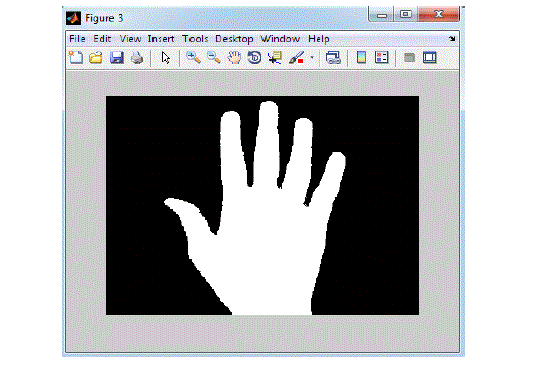 |
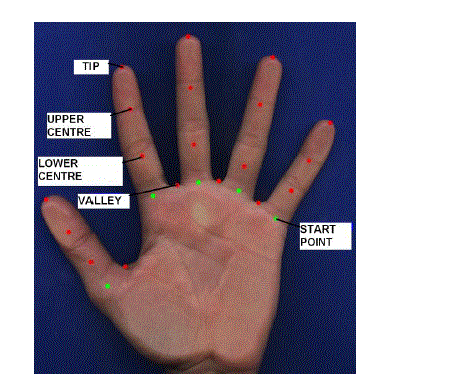 |
| Figure 5 |
Figure 6 |
Figure 7 |
|
References
|
- SaurabhParashar, AnandVardha, C.Patvardhan, Prem Kumar Kalra, “Design and Implementation of a Robust Palm Biometrics Recognition andVerification System.” Sixth Indian Conference on Computer Vision, Graphics & Image Processing, pp. 543-550, 2008
- Anil K. Jain ,Arun Ross ,SharathPankanti, “A Prototype Hand Geometry-based Verification System.” Proc. of 2nd International Conference on AudioandVideo-based Biometric Person Authentication (AVBPA), Washington D.C., pp.166-171, March 22-24, 1999.
- Singh, A.K.; Agrawal, A.K.; Pal, C.B. “Hand geometry verification system: a review” Ultra Modern Telecommunications & Workshops, 2009. ICUMT'09. International Conference , pp. 1-7, 2009
- W. Li, D. Zhang, and Z. Xu, “Palmprint identification by Fourier transform,” Int. J. Patt. Recognit. Art. Intell.,vol. 16,no. 4, pp. 417-432, 2002.
- J. You, W. Li, and D. Zhang, “Hierarchical palmprint identification via multiple feature extraction,” Pattern Recognition., vol. 35, pp. 847-859, 2002.
- Alexandra L.N. Wong1 and Pengcheng Shi2, “Peg-Free Hand Geometry Recognition Using Hierarchical Geometry and Shape Matching” MVA2002 IAPRWorkshop on Machine Vision Applications, pp 1-5,Dec. 11 - 13,2002, Nara- ken New Public Hall, Nara, Japan
- A. Kumar, D. C. Wong, H. C. Shen, and A. K. Jain, “Personal verification using palmprint and hand geometry biometric,” presented at the 4th Int. Conf.Audio- and Video based Biometric Person Authentication Guildford, U.K., pp. 1-8, June 9\–11, 2003
|